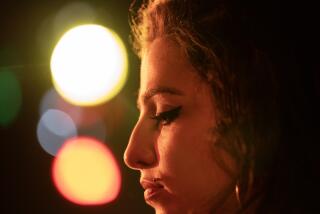Perspective: Rihanna’s videos present challenging issues
In the opening lines of “Take Care,” her duet with Drake on his new CD, Rihanna sings in a mesmerizing low voice, “I know you’ve been hurt by someone else / I can tell by the way you carry yourself. ... If you let me, I’ll take care of you / I’ve loved and I’ve lost.”
Covering, in snippet form, the blues staple “I’ll Take Care of You,” she gives one of the best vocal performances of her career. That’s not damning with faint praise. Her voice here is world-weary and mournful, bruised and compassionate, qualities that nudge “Take Care” into conversation with both the singer’s current No. 1 hit, “We Found Love,” and with the darker turn her music took with her last two CDs. (Her latest CD, “Talk That Talk,” is available this week.)
The runaway success of the melancholic retro-rave “We Found Love” certifies Rihanna as one of the most successful pop singers of all time, according to Billboard magazine. It’s her 20th Top 20 hit, amassed faster than any other solo artist in chart history. But it’s the video that really dazzles. On Oct. 20, film director Dennis Dortch (“A Good Day to be Black & Sexy”) tweeted the clip along with the comments, “Wow. I believe this to be flyest music video ever by a major (black) recording artist.” He later added, “I wish someone would cast her in an indie film.”
Directed by Melina Matsoukas, who also directed videos for Rihanna’s “S&M,” “Hard,” “Rude Boy” and “Rock Star 101” and whose résumé includes videos for Beyoncé and Lady Gaga, the “Love” clip centers on a modern-day, melanin-infused Sid and Nancy, played by Rihanna and boxer-turned-model Dudley O’Shaughnessy. We see the drug-addled couple at a skate park, outdoor rave, fish-and-chips spot, rampaging through a convenience store, and passed out on sidewalks. While filming the video in Ireland, Rihanna tweeted, “This is probably one of the deepest videos I’ve ever done. Its all about love and love being like a drug.”
Cribbing style elements from both punk and rave culture, the clip evokes Stephen Frears’ ‘80s anti-Thatcher British films “My Beautiful Laundrette” and “Sammy and Rosie Get Laid,” which juxtaposed the unvarnished romanticism of its flawed protagonists against a society in decline. The connection is deepened by the hook of “We Found Love,” which does all the song’s heavy lifting and which Rihanna sings plaintively: “We found love in a hopeless place.”
Such is the paradox of Rihanna that it’s been easy for a lot of pop fans and cultural critics to overlook the artistry that peppers her videography, especially clips that have come in the wake of 2009’s infamous Chris Brown episode. (Brown, her then boyfriend, assaulted her and left her visibly bruised.) Some of her music videos easily stand alongside those of critically acclaimed, academia-embraced darlings Beyoncé and Lady Gaga.
Under cover of starlet poses, something layered and moving, tense with contradiction, has begun emerging from the Rihanna brand — yes, in the music, but especially in her videos, where she is creating some of the most interesting pop fare of the moment.
A large part of the critical oversight is because early in her career, Rihanna evinced little personality or gravitas. She was (and is) a gorgeous girl with a banging body, decent dance skills and a so-so voice. She and her team have, however, shown an uncanny knack for reading cultural winds and knowing which sounds and trends are coming down the pike, the way Madonna used to do. Who’d have thought that the 17-year-old who sassily flounced through 2005’s “Pon De Replay” would ride the beat-driven experimentalism of “Umbrella” or the 4/4 Euro-synth dance-pop of “Don’t Stop the Music” up the charts two years later? Or would be singing about sadomasochism?
facile ode to the pleasures of whips, chains and the rough sex for which Rihanna has publicly proclaimed a fondness, opens with the singer being dragged to a podium by paparazzi and pinned under a layer of cellophane. She wears a dress made of newspaper headlines whose wording ranges from banal (“Barbados,” Rihanna’s birthplace) to disturbing (“whore”). These same words (along with “slut,” “daddy issues,” “bad boys”) also appear on journalists’ notepads and in a montage of newspaper headlines. Intercut are scenes of Rihanna performing the song while trussed in assorted S&M gear, all filtered through a Skittles candy-colored palette. (Rihanna recently settled out of court with photographer David LaChappelle, who sued over copyright infringement for some of the images used in the video. French photographer Philipp Paulus has a claim pending.)
Though Rihanna is playful and defiant in the clip, there’s also the element of the starlet under siege; the derogatory slurs mirror those deployed against Rihanna in the blogosphere/social media by young female fans of Brown who tore after her in defense of their fallen idol.
“Rude Boy” is Rihanna’s revisiting of dancehall culture, and the song’s blunt lyrics fuse a come-on with veiled emasculation (“Come here, rude boy / Boy, can you get it up? / Come here, rude boy / Boy, is you big enough? / Take it, take it …”) reflecting the frank, unapologetic sexuality of the genre.
Rihanna’s high-water video mark may be “Man Down,” released this year and an object of controversy. Gorgeously filmed, it opens with Rihanna’s character shooting a man in broad daylight, then it flashes back to the day before. We see her having a carefree day with friends and family before heading out for a night of clubbing. Sexily dressed, she takes to the dance floor and dances suggestively, attracting the attention of a man who, after being spurned, attacks her outside the club. In retaliation, she murders him in the morning.
Within days of its premiere, the clip, directed by Anthony Mandler, drew the ire of the Parent Television Council, which condemned the video for being “an inexcusable, shock-only, shoot-and-kill theme song.” Interestingly, they made no mention of the sexual assault that precipitated the murder and turned a deaf ear to the song’s lyrics, which express profound remorse for the killing.
Writing about the video for the Root website, Mychal Denzel Smith opined, “What Rihanna does in this video complicates our very simplistic narrative regarding women’s sexuality. Here we see that even if a woman is flirtatious and sexy and likes ‘whips and chains’ she has every right to turn down men she isn’t interested in sleeping with. And we see that there is no justification for her subsequent sexual assault, no matter what she was wearing or how she acted before it happened.”
Aishah Shahidah Simmons, producer-writer-director of “NO! The Rape Documentary” and an activist on behalf of rape victims, echoes that point. “While I don’t believe that violence in response to violence is the answer, I thought ‘Man Down’ was powerful. When a woman retaliates against her abuser/rapist, she’s often punished much more severely than her actual perpetrator,” she said. “I was stunned by the chorus of voices who were so outraged by ‘Man Down,’ yet many of those voices were silent when it came to the violence against the woman. Rihanna’s character challenges all types of norms that say women should not retaliate.”
Attempts to reach Rihanna were unsuccessful, but her thoughts can be gauged from tweets she made to fans in early June after the furor: “I’m a 23 year old rock star with NO KIDS! What’s up with everybody wantin me to be a parent? I’m just a girl, I can only be your/our voice! Cuz we all know how difficult/embarrassing it is to communicate touchy subject matters to anyone especially our parents!”
It would be callous to suggest that the Chris Brown incident was in any way a windfall for Rihanna, especially because she’s barely commented on it and has refused to be cast as a victim in the aftermath (in itself a powerful message). The shift we’ve seen over the last two years may have been in the cards, regardless. Yet the more sexually aggressive image did come in the wake of the assault and of Rihanna’s humiliation at being outed as a victim of domestic violence without her knowledge or consent.
There’s definitely a charged context for the evolution of her public image/persona. And that context provides a subtext that seems to have pushed her creative output into another key. Her videos have taken on meanings and messages (sometimes contradictory) that are too layered to be mere coincidence. Songs of heartache or romantic betrayal take on a darker cast when she sings them now. There aren’t many songs of heartbreak on “Talk That Talk.” The real test will be the mini-movies she and her crew come up with to illustrate, and complicate, the raunch in that collection’s grooves.
More to Read
The biggest entertainment stories
Get our big stories about Hollywood, film, television, music, arts, culture and more right in your inbox as soon as they publish.
You may occasionally receive promotional content from the Los Angeles Times.










